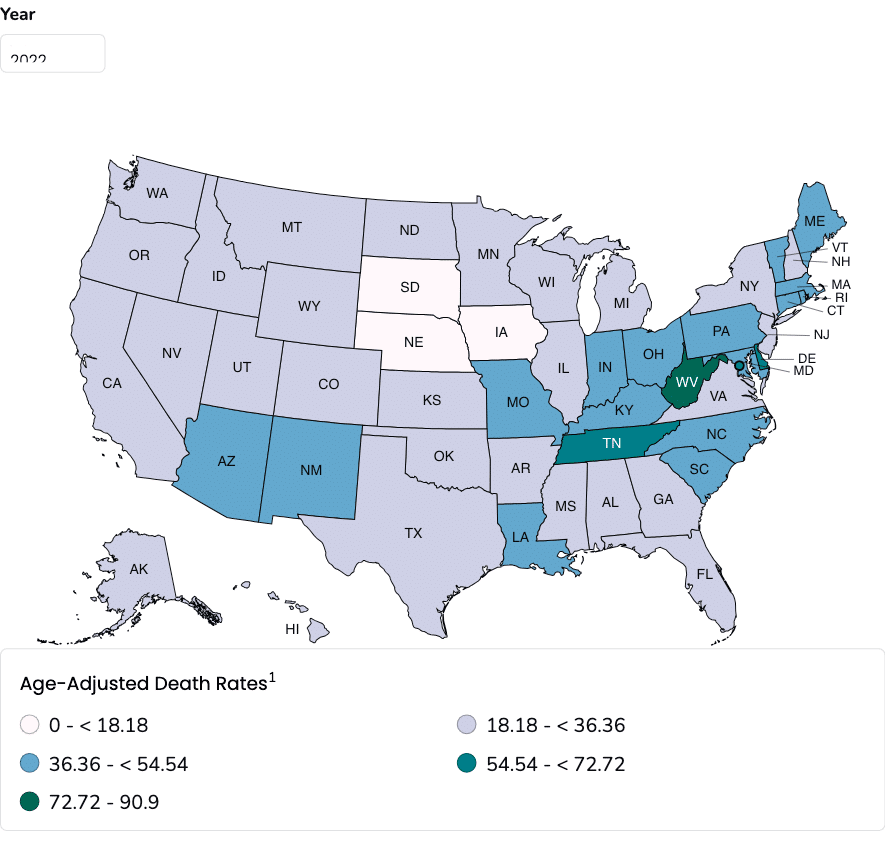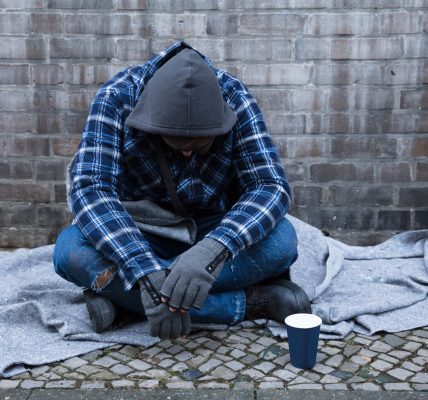Addiction, Overdoses, and Statistics

Quite recently, the Centers for Disease Control published a map and a set of charts illustrating the story of illicit drug overdose deaths in the USA in 2022, the most recent year for which statistics have been tallied.
A state’s figure represents the number of deaths from that cause, per each 100,000 members of the population. In terms of raw numbers, California is way up there with almost 11,000 overdose deaths, but when expressed in another way, that amounts to only about 27 fatalities per each 100,000 Californians, or about one-third as many per each 100,000 residents as the highest-rated state. (The very lowest figure, both in terms of raw head-count and percentage, is found in South Dakota.)
Way out in front is West Virginia with, in that year, 80.9 deaths per 100,000 people, or 1335 total. The next highest number of drug fatalities occurred not in a state, but in the headquarters of our government, the District of Columbia — 64.3 per 100,000 population — and what does that say about our national mental health?
Speaking of Washington, D.C., it is easy, in the nation’s capital, to get the impression that one hand doesn’t know what the other hand is doing. According to CNN reporters Deidre McPhillips and Connor Greene,
The Trump administration has named overdose prevention among its top drug policy priorities, but a preliminary budget proposal that was recently leaked suggests that it would cut about two dozen substance abuse prevention and treatment programs.
One of those threatened is a Substance Abuse and Mental Health Services Administration naloxone program that has been around for about a decade. It distributes opiate overdose rescue kits, and trains first responders, other professionals, and ordinary citizens in how to administer the treatment. From 2020 to 2022, the use of this lifesaver by laypersons almost doubled.
Narcan, the trade name under which naloxone is sold, has preserved many lives, particularly because it is effective against the unpredictably deadly substance known as fentanyl. But the $56 million per year program is on the chopping block, thanks to the current head of Health and Human Services (HHS):
HHS Secretary Robert F. Kennedy Jr. has talked about his own 14-year heroin addiction and recovery but has generally focused on the importance of preventing addiction through faith and community.
Oh, and banning cell phones in schools. Kennedy apparently believes this would reduce fatal incidents by reducing addiction overall, presumably because kids will have to wait until after school to contact their dealers. In and of itself, such a ban might be an excellent idea just for general educational reasons. But to rely on it as drug overdose deterrent? Not so much.
For The Mirror U.S., journalist Charlie Jones reports that certain states have seemingly achieved great improvement in saving overdose victims from death…
[…] but CDC officials voiced a note of caution. Some jurisdictions have had lags in getting death records to federal statisticians — particularly North Carolina, where death investigations have slowed because of understaffing at the state medical examiner’s office.
The CDC made estimates to try to account for incomplete death records, but the decline in some places may ultimately turn out not to be as dramatic as initial numbers suggest.
So it looks like the newly announced list of proposed federal budget cuts, which inevitably affect the states, will reverse many of the good effects that have been achieved in recent years. On the other hand, there is reason for optimism. The death-defying substance naloxone will allegedly soon be available over the counter in drugstores, so the average citizen can buy some and carry it around. Anyone who takes too much of an opiate will, in future, have the option of depending on either their own foresight, or the kindness of strangers, rather than on the preparedness of official personnel.
It is important, in such discussions, to avoid conflating addiction with either non-fatal overmedicating, or death. Some users are lucky enough to maintain their addiction for astonishing lengths of time (like Secretary Kennedy Jr. was able to) and somehow never cross the line into non-existence. Some users OD, and some die. Other users just sail along, occasionally getting wasted, but never actually becoming hooked, overdosed/saved, or dead.
Strangely, the absence of Narcan in the hands of potential rescuers could actually improve the statistics. If a person takes too much of an opiate, begins to die, and is rescued, they will live to possibly take too much on another day, and again be rescued — with each incident being counted as an overdose. One individual could conceivably chalk up dozens of overdoses, if each time they are rescued and given the opportunity to do it again at some future point.
If, on the other hand, they take too much and then die, only one OD — that fatal one — goes on the record. Thus, the cumulative number of OD incidents actually will be lower, making, in the long run, much tidier statistics.
Written by Pat Hartman. First published May 2, 2025.
Sources:
“Drug Overdose Mortality by State,” CDC.gov, undated.
“Despite pledge to expand naloxone access, Trump administration proposal would cut overdose prevention programs,” CNN.com, April 30, 2025.
“Map shows states with most drug overdose deaths as RFK puts an end to life saving narcan program,” TheMirror.com, April 29, 2025.
Image Copyright: Centers for Disease Control, used under Fair Use: Commentary.




